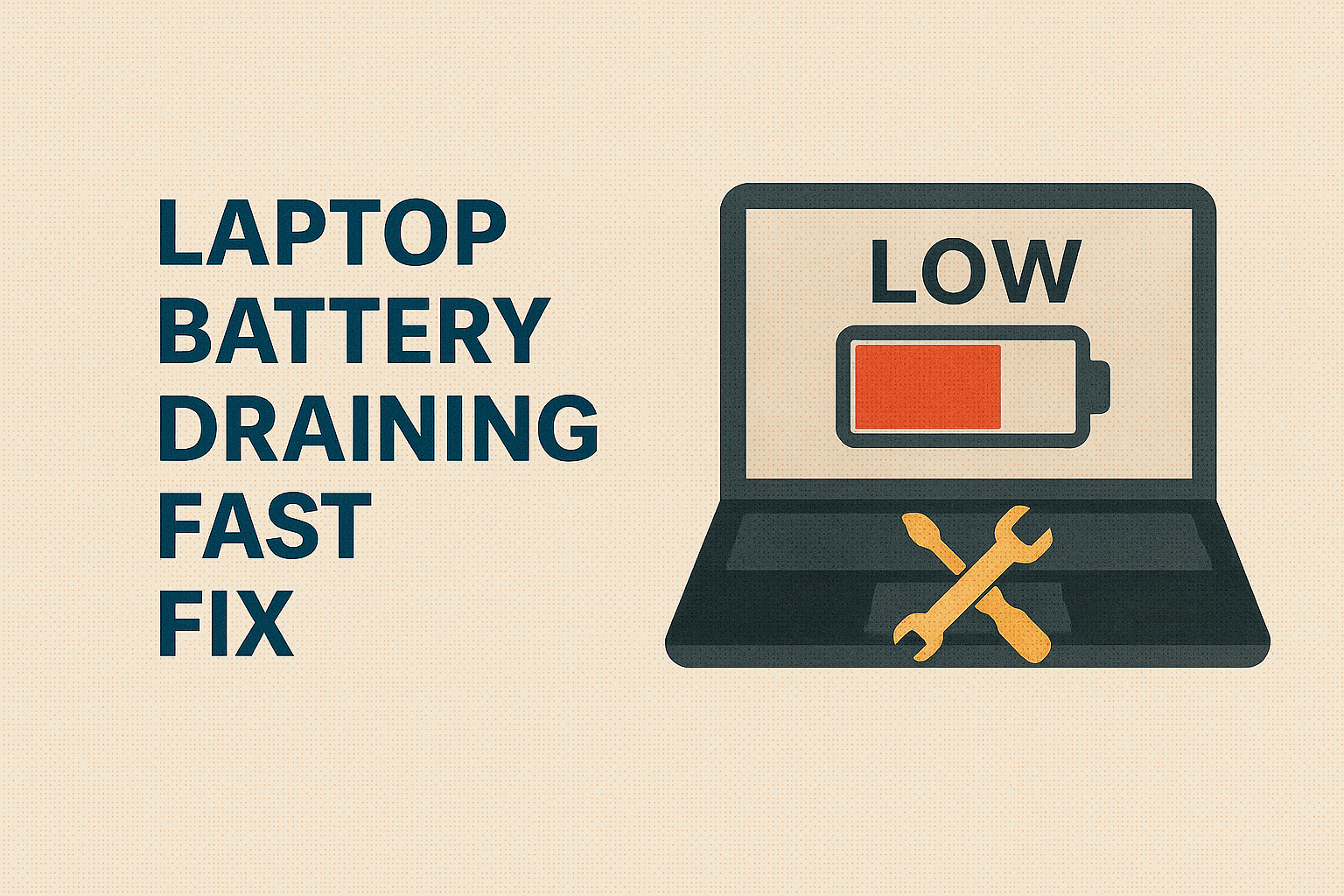Laptop Battery Draining Fast Fix: Step-by-Step Guide
A laptop’s portability is one of its greatest advantages. But when your laptop battery drains fast, it can quickly turn convenience into frustration. Whether you’re working, attending classes, or watching a movie, nothing is worse than seeing your battery percentage drop rapidly—even when you’re barely using your device.
This problem is common across Windows laptops, MacBooks, and even Chromebooks. The good news? Most of the time, it’s not the battery itself that’s faulty but background processes, system settings, or usage habits that drain power unnecessarily.
In this guide, we’ll cover the main causes of fast battery drain and provide a step-by-step solution guide to extend your laptop’s battery life.
Common Causes of Fast Laptop Battery Drain
Before jumping into fixes, it’s important to understand why your laptop battery drains quickly.
- High Screen Brightness – Keeping brightness at 100% is a major power hog.
- Background Apps – Programs running silently (like cloud sync or updates) consume battery.
- Power-Hungry Applications – Games, video editing tools, and heavy software drain resources.
- Wi-Fi & Bluetooth Always On – Keeping wireless connections active constantly uses energy.
- Battery Age – Over time, batteries lose capacity due to charging cycles.
- Outdated Drivers/OS – Old drivers and operating system glitches can cause abnormal drain.
- Faulty Charger or Charging Port – Sometimes the issue is with charging, not the battery itself.
By identifying the cause, you can apply the right fix.
Step-by-Step Fixes for Laptop Battery Draining Fast
1. Adjust Power & Sleep Settings
Windows and macOS come with built-in power management features. Optimizing them can improve battery life.
Windows Users:
- Go to Settings > System > Power & battery.
- Choose Battery saver mode or create a Power Saver Plan.
- Set the screen to turn off after 5–10 minutes of inactivity.
- Reduce sleep timer for better efficiency.
Mac Users:
- Go to System Settings > Battery.
- Enable Low Power Mode.
- Adjust display sleep and turn off “Enable Power Nap while on battery”.
2. Lower Screen Brightness
Your screen is one of the biggest battery consumers.
- On Windows, use Win + A to open quick settings and adjust brightness.
- On Mac, press the brightness keys (F1/F2).
Keep brightness at 40–60% indoors for a balance of clarity and power saving.
3. Close Background Applications
Applications like OneDrive, Dropbox, Google Drive, or Zoom keep running in the background, draining your battery.
How to Fix:
- Open Task Manager (Ctrl + Shift + Esc) on Windows.
- On Mac, use Activity Monitor.
- End unnecessary tasks.
4. Disable Wi-Fi & Bluetooth When Not Needed
Constant wireless scanning uses power.
- Turn off Wi-Fi if you’re working offline.
- Disable Bluetooth if you don’t use wireless devices.
On Windows: Win + A → Toggle Wi-Fi/Bluetooth Off.
On Mac: Click the Menu Bar icons to disable.
5. Update Drivers and Operating System
Outdated software can cause power mismanagement.
- On Windows: Go to Settings > Windows Update → Check for updates.
- On Mac: Go to System Settings > General > Software Update.
Also, update graphics drivers, chipset drivers, and BIOS/firmware for better energy management.
6. Unplug External Devices
USB devices like external hard drives, gaming controllers, and webcams keep drawing power.
Tip: Disconnect unnecessary peripherals when on battery.
7. Manage Startup Programs
Too many startup programs can cause unnecessary background activity.
Windows:
- Press Ctrl + Shift + Esc → Go to Startup Apps.
- Disable unnecessary apps.
Mac:
- Go to System Settings > General > Login Items.
- Remove apps you don’t need at startup.
8. Use Battery Saver Mode
Both Windows and macOS provide built-in power-saving modes.
- On Windows: Settings > System > Power & battery > Battery Saver.
- On Mac: Enable Low Power Mode in battery settings.
These modes automatically limit background apps, reduce brightness, and manage power for efficiency.
9. Check Battery Health
Sometimes the issue is not settings but the battery itself.
Windows:
- Open Command Prompt (Admin).
- Type:
powercfg /batteryreport - Check the battery health report.
Mac:
- Hold Option and click the Battery icon.
- It will show “Normal”, “Replace Soon”, or “Service Battery”.
If your battery is degraded, replacement might be the only fix.
10. Update BIOS/UEFI Firmware
A buggy BIOS can cause battery drain.
- Visit your laptop manufacturer’s support site.
- Download the latest BIOS/UEFI update.
- Follow official instructions carefully.
Comparison Table – Quick Fixes
| Fix Method | Difficulty | Effectiveness | Best For |
|---|---|---|---|
| Adjust Power Settings | Easy | High | Everyday use |
| Lower Screen Brightness | Easy | High | All laptops |
| Disable Background Apps | Medium | High | Performance issues |
| Update Drivers/OS | Medium | High | Long-term fixes |
| Replace Battery | Hard/Costly | Very High | Old laptops |
Advanced Fixes for Laptop Battery Draining Fast
Sometimes, the usual tweaks like lowering brightness or disabling background apps aren’t enough. If your laptop battery drains fast even after applying the basic steps, these advanced methods can help.
1. Update BIOS and Chipset Drivers
The BIOS manages your laptop’s hardware, including how power is distributed. Outdated BIOS or chipset drivers can cause inefficient battery usage.
- Visit your laptop manufacturer’s official support website.
- Download the latest BIOS update and chipset driver.
- Follow the instructions carefully during the update process.
Caution: Always plug in your laptop while updating BIOS to avoid interruptions.
2. Disable Fast Startup in Windows
Fast Startup makes Windows boot quickly but can sometimes cause laptop battery drain issues.
- Go to Control Panel > Power Options > Choose what the power buttons do.
- Click Change settings that are currently unavailable.
- Uncheck Turn on fast startup and save changes.
This setting reduces unnecessary background activity when your device is idle.
3. Check for Malware or Viruses
Malware consumes system resources, which increases power usage.
- Run a full system scan using Windows Defender or third-party antivirus software.
- Remove suspicious programs running in the background.
A malware-free system ensures longer battery life.
4. Replace Old or Faulty Battery
If your laptop is 3–5 years old, the battery health may have degraded. You can check battery health using:
- Windows PowerShell Command:
powercfg /batteryreportThis generates a detailed report of your battery performance.
If the report shows significant capacity loss, replacing the battery is the best laptop battery draining fast fix.
Comparison Table: Common Fixes vs. Advanced Fixes
| Method | Difficulty Level | Effectiveness | When to Use |
|---|---|---|---|
| Lower brightness & adjust sleep | Easy | Medium | Everyday usage |
| Disable background apps | Easy | High | Multitasking laptops |
| Update Windows & drivers | Medium | High | Performance issues |
| Update BIOS & chipset | Medium/Advanced | High | Old laptops |
| Replace old battery | Advanced | Very High | Worn-out devices |
This table shows that while quick fixes work temporarily, advanced solutions provide longer-lasting results.
Extra Tips to Improve Laptop Battery Life
Even after fixing the laptop battery draining fast problem, you should follow these habits to keep your battery healthy:
- Use Original Charger – Third-party chargers may not regulate power properly.
- Avoid Full Drain – Do not let your battery drop to 0% regularly.
- Keep It Cool – Heat is the enemy of batteries. Use a cooling pad if needed.
- Unplug When Fully Charged – Constant charging at 100% can degrade the battery.
- Hibernate Instead of Sleep – Hibernate saves more power when you don’t need your laptop for long hours.
FAQs on Laptop Battery Draining Fast Fix
1. Why is my laptop battery draining fast even when not in use?
This often happens due to background apps, outdated drivers, or fast startup mode being enabled. Disabling these settings can help.
2. Does keeping my laptop plugged in all the time damage the battery?
Modern laptops manage charging intelligently, but keeping it plugged at 100% for weeks may reduce long-term battery health.
3. How can I check my laptop’s battery health?
Run the command:
powercfg /batteryreport
This will generate a battery report in HTML format showing charge cycles, capacity, and efficiency.
4. Should I replace my laptop battery if it drains quickly?
If your laptop is older than 3 years and the battery health report shows significant capacity loss, replacement is the best option.
5. Which settings should I change for better battery life in Windows 10/11?
- Switch to Battery Saver Mode.
- Disable unnecessary startup apps.
- Turn off Bluetooth and Wi-Fi when not in use.
Conclusion
Laptop battery issues are frustrating, but they’re not permanent. With the right laptop battery draining fast fixes, you can restore performance and extend usage time. From simple steps like adjusting brightness to advanced methods like updating BIOS or replacing the battery, there’s always a solution available.
If your laptop still drains battery quickly after trying all fixes, it’s time to consult a professional technician or consider a new battery.
Don’t wait until your laptop shuts down during important work—apply these tips today and enjoy longer, hassle-free usage!


